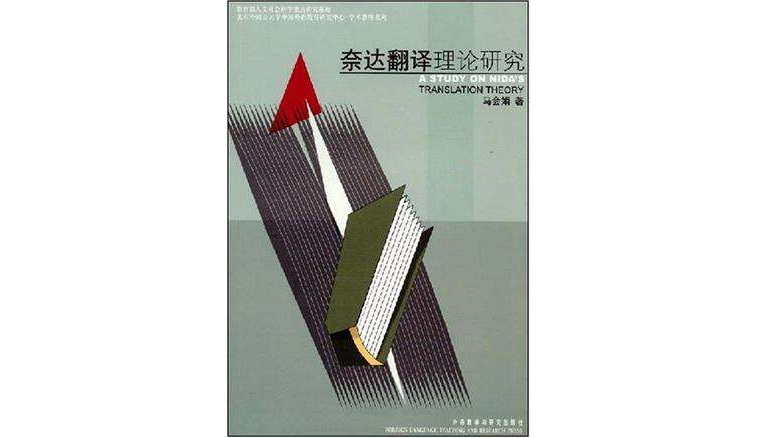《奈達翻譯理論研究》是2003年外語教學與研究出版社出版的圖書,作者是馬會娟。該書對奈達的翻譯理論作了較為全面、系統的研究,對譯界對它的研究狀況和接受情況進行了梳理、分析,澄清了譯界對奈達理論的種種錯誤認識,探討了譯界圍繞奈達理論進行的論爭及其根源。
基本介紹
- 書名:奈達翻譯理論研究
- 作者:馬會娟
- ISBN:9787560039206
- 頁數:250
- 定價:11.90元
- 出版社:外語教學與研究出版社
- 出版時間:2003-9
內容簡介
目錄
1.1 REASONS FOR FURTHER RESEARCH oN NIUA’S TRANSLATION THEORY
1.2 A PROFILEOFNIDA
1.2.1 Nida’s Earlier Study
1.2.2 His Involvement in the American Bihie Society
1.2.3 His Academic Contributions to Modern Linguistics and
Translation Theory
1.2.4 Nida’s Association with Chinese Translation Scholars
1.3 A SURVEY OF NIDA’S TRANSLATION THEORY
1.3.1 Nida’s Scientific Study of Tran~~ating
1.3.2 The Principle of Dynamic Equivalence
1.4 THE GUIDING PRINCIPLES OF THE RESEARCH
1.5 THE METHODOLOGICAL APPROACH
CHAPTER TWO REVlEWS OF NID A.S TRANSLATIoN THEORY
2.1 A SURVEY OF CHINESE TRADITIONAL TRANSLATION THEORY BEFORE THE 1980S
2.1.1 Debate over Literal and Free Translation ln Buddhist Translation
2.1.2 Translation Principles in the Late Qing Dynasty
2.1.3 The Dehares on“Fairbdufness”versus“Sraoothness” in the 1930s
2.1.4 Translation Criteria Acknowledged from the 1940s to the 1960s
2.1.5 Translation Studies During the“Cultural Revolution”
2.1.6 The Features of Chinese Traditional Translation theories
2.2 NIDAS TRANSLATION THEoRY IN CHINA
2.2.1 Popularity of Nidgs Theory from 1981 to the Late 1980s
2.2.2 Rethinking Nida's Theory from the Late 1980s through the Mid-1990s
2.2.3 Denial of Nida's Theory from the Mid-1990s to the Present Time
2.2.4 Problems in the Studies of Nidgs Theory in China
2.3 AN OVERVIEW oF WESTERN TRANSLATION THEORIES REFORE NIDA
2.3.1 Early Statements on Translation During the Period of Roman Empire
2.3.2 From the Renaissance to the Eighteenth Century
2.3.3 The Nineteenth Century
2.3.4 The First Half of the Twentieth Century
2.4 NIDAS TRANSLATloN THEORY IN THE WESTERN WORLD
2.4.1 Influence ofNida'sTheory
2.4.2 Criticism of Nida's Theory
2.4.3 Rejection ofNidgsTheory
2 4.4 Problems in the Studies of Nidgs Theory in the West
CHAPTER THREE A STUDY ON NIDA'S TRANSLATl0N THEORY
3.1 NIDRS VIEWS OF LANGUAGE AND CULTURE
3.1.1 NidgsView of Language
3.1.2 Nida'sView ofCulture
3.2 NIDAS SCIENCE oF TRANSLAIoN
3.2.1 The Nature of Nida's Science of Translation
3.2.2 The Distorted“Science of Translation”in China
3.2.3 Nida's Science of Translation and ChomskCs TG Grammar
3.3 NIDAS CONCEPT OF TRANSLATloN EQUIVALENCE
3.3.1 Translation Equivalence in Western Countries
3.3.2 Translation Equivalence in China
3.3.3 Nida's Concept of Equivalence
3.4 DYNAMIC EQUIVALENCE/FUNCTIONAL EQUIVALENCE
3.4.1 Phase I Dynamic Equivalence and Formal Equivalence
3.4.2 Phase II Dynamic Equivalence and Formal Correspondence
3.4.3 Phase III:Functional Equivalence and Formal Correspondence
3.5 CONTROVERSIES oVER DYNAMIC EQUIVALENCE/FUNCTIONAL EQUIVALENCE
3.5.1 Dynamic Equivalence and Reader-Response Theory
3.5.2 Content and Form
3.5.3 Naturalization and Foreignization
3.6 TESTING NInA'S THEORY WITH SPECIAL REFERENCE TO BIBLE TRANSLATIoN
3.6.1 The History of Bible Translation into English
3.6.2 Testing Nidgs Theory with Examples from Today's English Version
3.6.2.1 Translating Idioms
3.6.2.2 Reconstructing Formal Structures
3.6.2.3 Translating Figurative Expressions
3.6.2.4 Making Explicit Implicit Information
3.6.3 The History of Bible Translation into Chinese
3.6.4 Testing Nidgs Theory with Examples from Todays Chinese Version
3.6.4.1 Translating Idioms
3.6.4.2 Reconstructing Formal Structures
3.6.4.3 Translating Figurative Expressions
3.6.4 4 Making Implicit Information Explicit
3.6 5 Problems in the TEV andtheTCV
CHAPTER FOUR A CoMPARATIVE STUDY OF NIDA'S THEORY AND JIN DI'S THEORY
4.1 JIN DI’S TRANSLATl0N THEORY
4.1.1 A Survey of Jin's Translation Activity and Translation Study
4.1.2 Jin's View on Translation Before His Reception of Nida's Theory
4.1.3 Jin's Theory of Equivalent Ef~~ct and Its Relationship with Nida's Theory
4.2 RETHINKING NIDA’S DYNAMIC EQUIVALENCE
4.2.1 The Relationship between Dynamic Equivalence and the Principle of Equivalent Effect
4.2.2 The Scientific Basis of Dynamic Equivalence/Functional Equivalence
4.2 3 The Immediate Concern of Dynamic Equivalence
4.3 JIN'S RoLE IN PoPULARIZING NIDA'S THEORY
4.3.1 Jin's Contribution to a Better Understanding of Nida's Theory
4.3.2 Problems with Some of Jin's Views about Nida's Theory
4.4 DIFFERENCE BETwEEN JIN’S THEoRY AND NIDA'S THEORY
4.4.1 Reader-Oriented vs Text-Oriented
4.4.2 Flexible vs Inflexible
4.4.3 Ideal Objective vs Realistic Goal
4.4.4 Reasons for the Differences between Jin's Theory and Nida's Theory
4.5 COMMENT ON JIN'S CHINESE VERSION OF ULYSSES
4.5.1 Successful Representation of Stream of Consciousness
4.5.2 Successful Representation of Normal Narratives
4.5.3 Problems in Jin’s Chinese Version of Ulysses
4.5.4 Implications of Jin's Translation Practice for the Applicability of Nida's Theory to Literary Translation
CHAPTER FIVE ATIlEMPTS TD FURTHER AMEND NIDAS TRANSLATlON THEORY
5.1 THE APPLICATIONOF NIDAS THEORY TO LITERARY
TRANSLATIoN
5.1.1 The Application of Dynamic Equivalence
5.1.2 The Significance of the Concept of the Decoder's Channel Capacity
5.1.3 The Important Role Receptors Play in Evaluating Literary Translation
5.2 THE LIMITATIoNS OF NIDAS THEORY IN LITERARY TRANSLATION
5.3 THE IMPORTANCE OF TRANSFERRING AESrHETIC VALUES IN LITERARY TRANSLATl0N
5.4 TRANSFERRING AESTHETIC VALUES IN LITERARY TRANSLATION
5.4.1 Transferring Formal Aesthetic Mafres
5.4.2 Transferring Non-formal Aesthetic Markers
5.4.3 Transferring Aesthetic Values of a Literary Text as a Whole
5.5 TESTING THE REPRESENTATION OF AESTHETIC VALUES IN LITERARY TRANSLATION
5.5.1 Objective Factors Partiality of Translation
5.5.2 Subjective Factors the Translator and the Reader
5.5.3 Questionnaire Analysis of Literary Translation
CHAPTER SIX CONCLUSION
NOTES
APPENDIX
BIBLIOGRAPHY~

